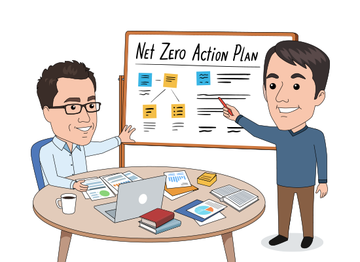The Instigator is co-authored again this week by my friend Peter Ebsen. In our last post, Peter and I offered recommendations on how to improve corporate net-zero climate pledges, based on our recent submission to the Science Based Targets initiative. We asked for feedback and got it. Thank you. This week, we develop the “why” behind our recommendations and address some of the challenges we anticipate and some of the criticisms we have received.
Let’s pause for a moment of reflection. We have found common ground in the fight against climate change. We all agree that net-zero is the goal and 2050 is the deadline. That’s a solid foundation for us to build on.
Where we’re less clear are the specifics. How will we get there? What will it take? Who must act in what ways? Who must we protect? Without greater consensus, our efforts will never be as aligned and as powerful as they can be.
In our last post, Peter and I laid out a vision for a climate-radical, business-friendly, socially just, and fully transparent path to net-zero. It involved accelerated timelines for corporate commitments, detailed disclosures, and treating carbon removal as functionally equivalent to reducing emissions. We argued that this was necessary for two reasons:
- It is not viable to reach net-zero by 2050 at the current pace of our efforts. Rather than kick the can further down the road, we’re asking for more action now by those who can afford to take it. And for those who cannot, show us your plan—with specific details—what you can do now and why you cannot do more.
- It is the more just and equitable way to make climate progress. The costs of climate action get passed along to consumers, the impact of which will always be disproportionately borne by those with the least resources to spare. We favor a framework that delivers climate action at the lowest possible costs and stimulates innovation to bring these costs down even further. Furthermore, billions of people around the world are increasingly sharing in the benefits of prosperity that a select minority has had the privilege to enjoy for decades. For this to continue, climate action will need to be consistent with global economic growth.
Let’s first make our recommendations concrete.
What does a net-zero commitment look like in practice for a company?
Imagine you’re the CEO of a cement company. You’ve agreed to make a net-zero commitment for 2050. You’re not sure how the company will achieve that goal, but you take comfort in the fact that you have 29 years to do this. And of course, it will not be your responsibility alone, but that of several CEOs to follow. (You’re aware that the average tenure of sitting CEOs in the S&P 500 is about 6 years.)
What should you do? Your company is already energy efficient. You can’t find any easy or low-cost ways to reduce emissions. Further, your industry is very competitive. If you raise prices to cover higher costs, you’ll lose market share.
In our view, the following scenario is win-win in a world where we all agree that corporate action is desperately needed:
- You state that your company will:
a. embrace the global transition to net-zero
b. ensure that all greenhouse gas emissions in its operations, supply, and value chain will be balanced with carbon dioxide removals
c. reach this goal as quickly as possible - You implement an advocacy strategy that helps regulators to create a level playing field for net-zero positive companies such as yours.
- You analyze the greenhouse gas emissions in your company’s operations, supply, and value chain. What are the options to reduce them? What are the costs per ton of emission reduction?
- You analyze the carbon dioxide removals in your company’s operations, supply, and value chain. What are the options to increase them? What are the costs per ton of carbon dioxide removal?
- You implement a net-zero strategy that drives down the costs of your net emission reductions while actively pursuing net-zero transition growth opportunities in your supply and value chain and beyond.
- You report on your progress. You are transparent about your goals, your situation, and your achievements. Your company will get better at net-zero fast. This will allow you to continually revise your goals and make them more and more ambitious.
This approach works for companies that are in a situation to move to net-zero immediately or during the next few years. But crucially it also works for companies who are not in that position. Some companies may require additional encouragement and support from others, such as regulators, their stakeholders, customers, and suppliers. That is fine. At this stage, the most important thing is that companies actively pursue a net-zero strategy and are transparent about their approach, goals, and obstacles.
Answering our Challengers
We’ve received some very thoughtful questions and pushback on our ideas. This is good. We want to have the difficult conversations, find the flaws in our logic, and leave no stone unturned in our quest to achieve net-zero.
We will address the challenges we’ve heard one by one. Our guiding framework is: what do we need to do now to realize our net-zero goal by 2050. The answer we keep coming back to? Waiting does not help.
